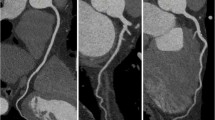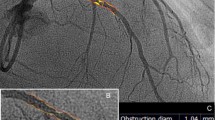Summary.
Selective coronary angiography allows the precise definition of highly stenotic coronary lesions and therefore remains the basis for catheter-based or surgical myocardial revascularization. However, the accumulation of atherosclerotic plaque in the coronary arterial wall begins much earlier than the development of luminal stenosis. In fact, most acute coronary syndromes are initiated by sudden disruption of atherosclerotic plaques that caused neither significant stenosis nor angina pectoris prior to the event. These early, but potentially vulnerable, lesions are therefore the topic of intensive research but their description with angiography alone is incomplete.
Invasive, tomographic imaging modalities, in particular intravascular ultrasound, allow direct visualization of the atherosclerotic plaque and therefore supplement angiography. These techniques have advanced our understanding of coronary artery disease (CAD) progression and stability but are limited because of their invasive character. Current developments in particular of computed tomography already allow the non-invasive imaging of coronary arteries and may have an important role in the early identification of CAD and the prevention of its complications.
Zusammenfassung.
Die selektive Koronarangiographie erlaubt die detaillierte Untersuchung der Herzkranzgefäße mit bisher unübertroffener räumlicher und zeitlicher Auflösung und ist deshalb die Basis für perkutane und chirurgische revaskularisierende Maßnahmen im Stromgebiet von hochgradigen Koronarstenosen. Allerdings beginnt die Entwicklung atherosklerotischer Plaques typischerweise lange bevor dem Auftreten von angiographischen Stenosen, und die Mehrzahl der akuten koronaren Ereignisse (instabile Angina und Herzinfarkt) wird durch den plötzlichen Bruch eines atherosklerotischen Plaques ausgelöst, der im Vorfeld keine hochgradige Stenose oder Angina pectoris verursachte. Mit zunehmendem Interesse widmet sich deshalb die Forschung der frühen Entwicklung von koronaren Plaques, die mit der Angiographie allein nur unzureichend beschrieben werden können.
Invasive, tomographische bildgebende Verfahren, insbesondere der intravaskuläre Ultraschall (IVUS), ermöglichen die direkte Darstellung des atherosklerotischen Plaques und ergänzen damit angiographische Untersuchungen des Gefäßlumens. Die direkte Betrachtung der Gefäßwand mit diesen Methoden hat unser Verständnis der Plaque-Entwicklung und -Stabilität erweitert. Aufgrund des invasiven Charakters sind diese Methoden aber in der klinischen Praxis nur beschränkt einsetzbar. Gegenwärtige Entwicklungen insbesondere der Computertomographie (CT) erlauben die nicht-invasive Darstellung der Koronararterien und könnten eine Rolle in der frühen Identifikation der Koronaren Herzerkrankung (KHK) und der Prävention ihrer Komplikationen spielen.
Similar content being viewed by others
Author information
Authors and Affiliations
Additional information
Eingegangen: 26. September 2002, Akzeptiert: 17. Januar 2003
Correspondence to: MD FACC E. Murat Tuzcu
Rights and permissions
About this article
Cite this article
Schoenhagen, P., White, R., Nissen, S. et al. Darstellung und Quantifizierung von atherosklerotischen Plaques in den Koronargefäßen . Z Kardiol 92, 429–437 (2003). https://doi.org/10.1007/s00392-003-0925-4
Issue Date:
DOI: https://doi.org/10.1007/s00392-003-0925-4




